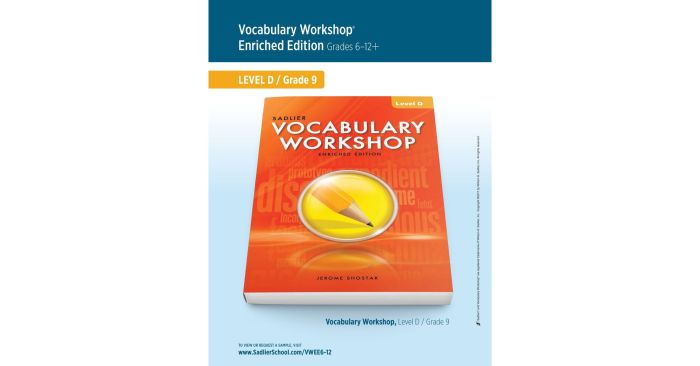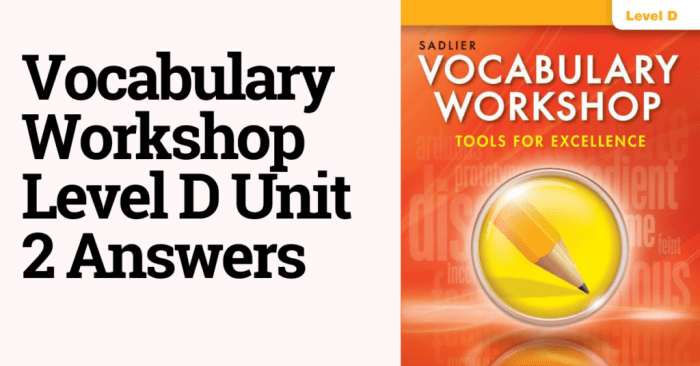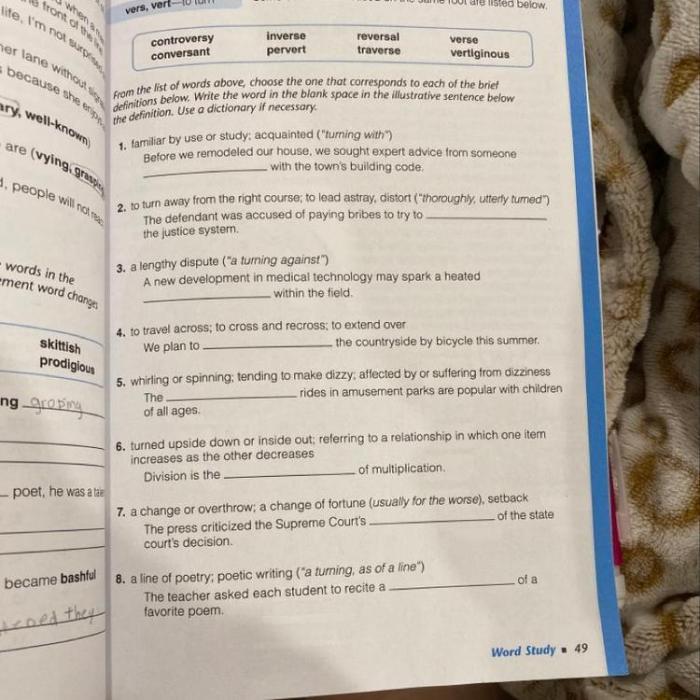Embark on a linguistic adventure with Vocab Book Level D Answers, a comprehensive guide to unlocking the complexities of language. Delve into the nuances of advanced vocabulary, unravel the secrets of word relationships, and enhance your communication skills with confidence.
Our exploration begins with foundational concepts, empowering you with strategies to conquer complex words and master their meanings. We’ll navigate the intricacies of context, unraveling techniques to infer meaning and determine word usage with precision.
Vocabulary Level D Concepts

Vocabulary Level D introduces learners to a wider range of complex and nuanced words, building upon the foundational concepts established in earlier levels. These words are essential for effective communication and critical thinking in academic and professional settings.
Understanding Abstract Concepts
At this level, learners encounter abstract concepts and words that describe intangible ideas, emotions, and qualities. These words often have multiple meanings and require careful consideration of context to grasp their full significance. For instance, words like “integrity,” “empathy,” and “ambivalence” require an understanding of the underlying principles and values they represent.
Contextual Understanding
Understanding words within context is crucial for accurate comprehension. Surrounding text provides valuable clues that help us infer meaning and determine word usage.
Techniques for Inferring Meaning
- Examine the sentence structure:Identify the subject, verb, and object to understand the basic meaning.
- Consider the paragraph or passage:The broader context provides additional information that can clarify word usage.
- Use a dictionary or thesaurus:Look up unfamiliar words to find their definitions and synonyms.
- Pay attention to tone and style:The author’s tone and writing style can influence word choice and meaning.
Determining Word Usage
Context clues help us determine how words are used in a specific context:
- Synonyms and antonyms:Words that have similar or opposite meanings can clarify the meaning of unfamiliar words.
- Definitions:The author may provide direct definitions or explanations of unfamiliar words within the text.
- Examples:Examples illustrate how a word is used in practice, making its meaning clearer.
- Comparisons and contrasts:Comparing and contrasting words can highlight their similarities and differences.
Word Relationships: Vocab Book Level D Answers
Word relationships are the connections between words that help us understand their meaning and use them effectively in communication. These relationships include synonyms, antonyms, and homophones.
Synonymsare words that have the same or similar meanings. For example, “happy” and “joyful” are synonyms. Antonymsare words that have opposite meanings. For example, “hot” and “cold” are antonyms. Homophonesare words that sound the same but have different meanings and spellings.
For example, “there,” “their,” and “they’re” are homophones.
Understanding these word relationships enhances vocabulary by expanding our knowledge of word meanings and helping us to use words accurately and effectively.
Exercises to Foster Comprehension of Word Relationships
- Synonym Matching:Match words with their synonyms from a given list.
- Antonym Identification:Identify the antonym of a given word.
- Homophone Sorting:Sort words that sound the same but have different meanings and spellings.
- Contextual Usage:Use synonyms and antonyms to complete sentences in a meaningful way.
Morphological Analysis
Morphological analysis is the study of the internal structure of words, including prefixes, suffixes, and roots. Understanding these components can greatly enhance vocabulary building and comprehension.By breaking down words into their constituent parts, we can better grasp their meanings. Prefixes are added to the beginning of words to modify their meaning, while suffixes are added to the end of words to change their part of speech or grammatical function.
Roots are the core meaning-carrying units of words.
Identifying Prefixes, Suffixes, and Roots
To identify prefixes, suffixes, and roots, consider the following strategies:
- Look for familiar prefixes and suffixes:Many prefixes and suffixes are commonly used, such as “un-” (not), “re-” (again), “-tion” (action), and “-ly” (adverb).
- Check the dictionary:If you’re unsure about the meaning of a prefix or suffix, consult a dictionary.
- Break down the word into smaller parts:Divide the word into smaller units until you reach the root. The remaining parts are likely prefixes or suffixes.
Understanding Word Meanings through Morphological Analysis
Morphological analysis helps us understand word meanings by:
- Identifying the root meaning:The root carries the core meaning of the word.
- Modifying the root meaning:Prefixes and suffixes alter or refine the root meaning.
- Building new words:By combining different prefixes, suffixes, and roots, we can create new words with distinct meanings.
For example, consider the word “unhappy.” The root “happy” conveys a positive emotion, while the prefix “un-” negates this meaning, resulting in the opposite emotion.
Vocab book level D answers are quite the challenge, but don’t fret! If you’re looking for a deeper dive into the complexities of love and fate, check out this thesis on Romeo and Juliet . It offers a fresh perspective on the iconic Shakespearean tragedy, exploring the themes of love, fate, and the consequences of rash decisions.
And hey, who knows, it might even inspire you to ace those vocab book level D answers!
Assessment and Practice

To ensure effective vocabulary acquisition, regular assessment and practice are essential. This not only gauges learners’ progress but also helps reinforce and strengthen their understanding of new words.
Assessment Methods
Various assessment methods can be employed to evaluate vocabulary knowledge:
- Formal Tests:Structured assessments like multiple-choice tests or fill-in-the-blanks can provide objective data on learners’ vocabulary recall and comprehension.
- Informal Observations:Observing learners’ use of new words in class discussions, presentations, or writing assignments can offer insights into their vocabulary application.
- Self-Assessment:Encourage learners to reflect on their vocabulary progress and identify areas for improvement through self-assessment tools like vocabulary logs or progress charts.
| Assessment Method | Benefits |
|---|---|
| Formal Tests | Objective data, comprehensive evaluation |
| Informal Observations | Real-time insights, formative feedback |
| Self-Assessment | Learner ownership, motivation |
Practice Activities
To reinforce vocabulary learning, incorporate engaging practice activities that cater to diverse learning styles:
- Word Games:Crossword puzzles, word searches, or anagrams challenge learners to actively recall and apply vocabulary.
- Concept Mapping:Encourage learners to create visual representations of vocabulary concepts, connecting them to prior knowledge.
- Vocabulary Journals:Have learners maintain a journal where they record new words, definitions, and examples, fostering independent vocabulary building.
- Collaborative Discussions:Engage learners in group discussions where they use new vocabulary to express ideas and perspectives.
- Creative Writing:Provide opportunities for learners to incorporate new words into creative writing tasks, enhancing their fluency and usage.
Real-World Applications

Vocabulary is a key to unlocking success in various aspects of life. It’s not just about using fancy words to impress others; it’s about expressing yourself clearly, understanding others effectively, and critically evaluating information.
A robust vocabulary empowers individuals to communicate their thoughts and ideas with precision and impact. By knowing the right words, they can articulate their messages in a way that resonates with the audience, whether it’s during a presentation, negotiation, or casual conversation.
Enhanced Comprehension
A strong vocabulary also enhances comprehension. When reading or listening, individuals with a broader vocabulary can decipher the meaning of complex texts and conversations more easily. They can grasp the nuances of language, identify hidden meanings, and make connections between different pieces of information.
Critical Thinking
Vocabulary plays a crucial role in critical thinking. It enables individuals to analyze information, identify biases, and evaluate arguments. By understanding the precise meaning of words, they can dissect complex concepts, question assumptions, and draw informed conclusions.
Academic and Professional Success, Vocab book level d answers
In the academic world, a strong vocabulary is essential for success. Students who possess a wide range of vocabulary are better equipped to understand textbooks, write essays, and participate in discussions. Similarly, in the professional realm, individuals with a rich vocabulary can excel in negotiations, presentations, and networking events.
FAQs
What is the significance of context in vocabulary acquisition?
Understanding words within context provides valuable clues about their meaning, allowing you to infer their usage and expand your vocabulary beyond mere definitions.
How do word relationships enhance vocabulary?
Exploring relationships like synonyms, antonyms, and homophones deepens your understanding of word nuances, expanding your vocabulary and improving your communication skills.
What is the role of morphological analysis in vocabulary building?
Breaking down words into their prefixes, suffixes, and roots reveals their etymological origins, aiding in understanding their meanings and expanding your vocabulary.